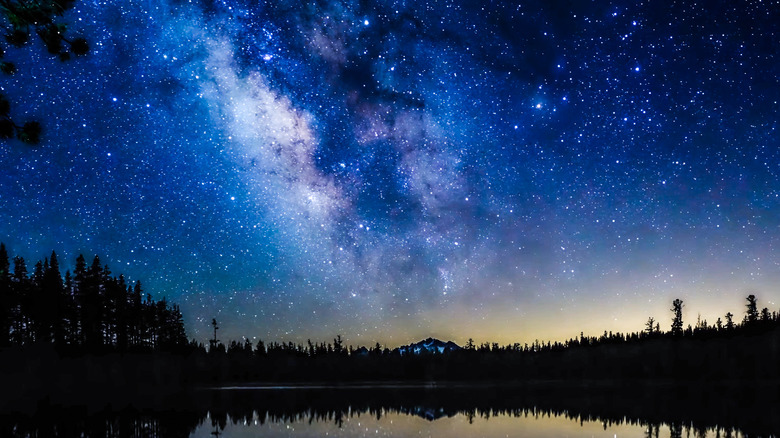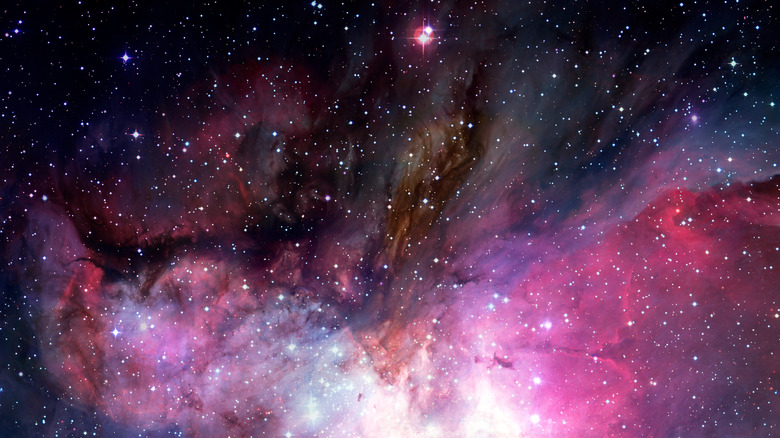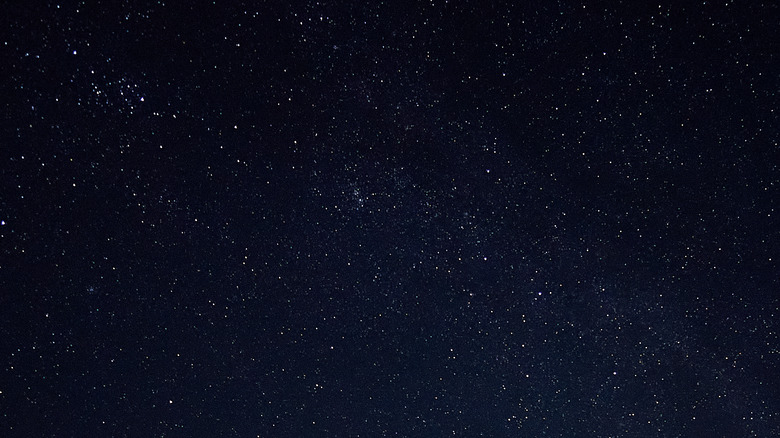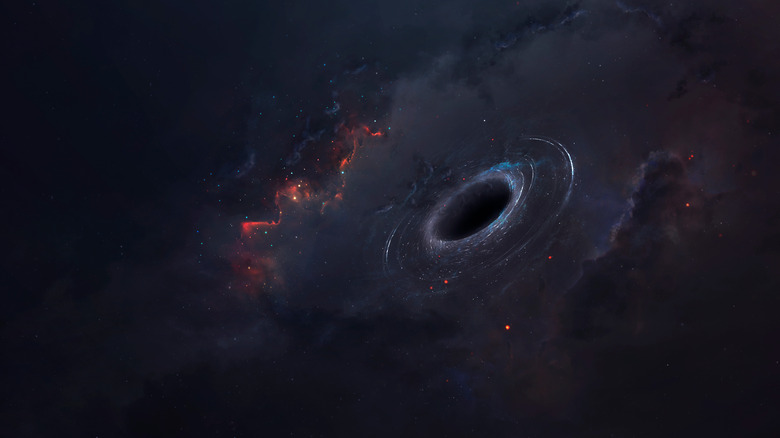The Truth About The 'Stelliferous Era' Of The Universe
Some folks might complain that an eight-minute video is "sooooo long," and click off of it halfway through. To others, a 45-minute commute might "feel like forever." Yet others might say they "can't wait" to pay off their car in, say, two years. Human beings measure their ever-constricting sense of time by the transience of a single life. Seventy, 80 years, maybe? But by any objective measure, anything — indeed all things — done by human hands, constitutes a mere mote in the blink of the eye of the cosmos.
Windows 95 was many people's first access to the internet, using a cable, dial-up connection, and modem. How much has the world changed in the 25 years since? The first "electric light" was invented in 1802 by Humphry Davy, per Bulbs. About 1,300 years before that the Western Roman Empire fell in 476 CE, according to History. Evidence for the first human writings, a partial script, appeared in ancient Sumer about 3,400 BCE, per the British Library. As the Atlantic explains, Homo Sapiens, thanks to what linguists call "laryngeal descent," started muttering the beginnings of spoken language around 200,000 years ago. The first hominids appeared in Africa about 2,000,000 years ago, per Smithsonian Magazine.
And the universe itself? 13.8 billion years old. Earth is about 4.5 billion years old, per Space. All stars, planets, even molecules: all of it will one day be gone. Stars, and life as we know it, can only exist now, during the universe's "Stelliferous Era."
The age of stars will eventually end
Discussions like these can get heavy, terrifying, and existentially nightmarish, fast. Feel free to take a breather if you have to.
The term "Stelliferous Era" comes from the familiar word "stellar," which of course relates to "stars." Don't go thinking that stars themselves — billions of years old, many of which are so far away from us that their light will never reach us because the universe is expanding faster than the speed of light — will last forever, coalescing, colliding, forming new galaxies and stellar nebulae. They won't. One day, the light of the cosmos will switch off, and there will be no more new stars, no more matter, not a single iota of energy whatsoever. Even the most constituent subatomic particles like quarks will vanish.
Stars can only exist now. Hence: the Stelliferous Era, or "cosmological decades" 6 through 14, as the University of Michigan explains (more on those later). Universes themselves, like stars, planets, lions, roses, have life cycles. Here, now, like a single breath, is the one time for life such as us to exist.
How do we know this? The universe has existed long enough for the initial expulsion and ballooning of space, starting with the Planck Epoch that lasted 10-44 seconds, per Big Think, to form stars. But because the universe is ever-expanding, eventually, stars, galaxies, everything, will be too far apart to collide. Stars will peter out, and black holes will engulf the entirety of reality.
We are in the second of the universe's five eras
The universe itself exists in five eras: the Primordial Era, the Stelliferous Era (now), the Degenerate Era, the Black Hole Era, and the Dark Era, as Big Think outlines. When thinking about the age of the universe, its origins and ultimate fate, it's important to discard any concepts of time as we might experience it here in our lives on Earth, getting coffee, showering, texting friends, things like that. Instead, abandon those notions and embrace vastness and incomprehensibility. Truly.
The Primordial Era came directly after the Big Bang. Super-hot plasma raged, physics were weird, and in an instant, the universe blew up to 100 trillion-trillion times its original size. Within 20 minutes, particles cooled and started sticking together. The first stable atoms formed about 380,000 years after the Big Bang, which we detect nowadays as "cosmic background radiation." Electrons "gobbled up" photons, which is why space looks, well, black (opaque, really).
The Stelliferous Era, as Medium says, is the one "window of opportunity" for matter to cohere into massive gas clouds, then superheat into blazing neutron-and-hydrogen stars. They get caught, in groups of hundreds of billions, around supermassive black holes like that at the center of our galaxy, the Milky Way. Eventually, entire galaxies will collide with each other, like the Milky Way and the Andromeda Galaxy in 4 billion years. Merger after merger of stars will create larger and larger systems that will cool, and eventually, die.
A lightless, frozen universe saturated with black holes
It's helpful at this point to bring back the term "cosmological decade;" this is the best way to measure time on such a grand scale. A cosmological decade describes a ten-fold increase in the number of years since the Big Bang. In other words, 10 cosmological decades is equal to 10 billion years (1010), per The New York Times. Each era of the universe gets longer and longer, and for all intents and purposes, the final era might as well be infinity.
In the Degenerate Era (cosmological decades 15-37), as the University of Michigan explains, the only stellar bodies will be "white dwarfs, brown dwarfs, neutron stars and black holes." Galaxies will destabilize, black holes devour more matter, and the only new stars to form will be brown dwarfs colliding once every quadrillion years (115). Universal energy levels will continue until an entire galaxy emits no more light than a single current-day star. Eventually, even dark matter will dissipate, and all protons decay.
Then comes the horrifying Black Hole Era (cosmological decades 38-100), a lightless, frozen era of random, zooming particles doomed to be captured by a universe-saturating expanse of galaxy-sized black holes that, themselves, collide and grow bigger and bigger. Note that this era is longer than the three preceding eras combined. Small black holes, as Big Think says, take about 1068 years to leak away all the energy they've claimed (provided they don't receive more). Supermassive black holes? 1098 to 10100 years.
The Heat Death of the Universe
Finally, we've got the much-ballyhooed "Heat Death of the Universe." It was once commonly thought that the universe would end in parity, with a bookended "Big Crunch" to mirror the "Big Bang." The universe would collapse back on itself and shrink into another infinitesimally small point that would erupt into another Big Bang. And so the universe itself, as Hinduism teaches (recapped on Medium), is caught in a cycle of reincarnation.
Unfortunately for anyone's notion of an immortal soul, it looks like we're instead going to head towards a "Big Freeze," or the "Heat Death of the Universe," a point of no-return maximum entropy. Still-fathomless "dark energy" — dark because we know it exists, but have no idea what it is, as Cosmos Magazine explains — continues to propel the universe apart from its origin point. This accounts for "red shift," whereby further objects in space appear more red because their wavelengths have been stretched by the expansion of space itself.
Eventually, even black holes will emit their final blips of entrapped energy and themselves die. This era, the Dark Era (past cosmological decade 100), will be characterized by a universe effectively locked in absolute zero temperatures, full of absolutely nothing but a sea of scattered complex particles that themselves will decay into the abyss of eternity.
So what's our point? The next time someone complains "this movie is so long," remind them that, cosmologically, even the era of stars is pretty dang short.




